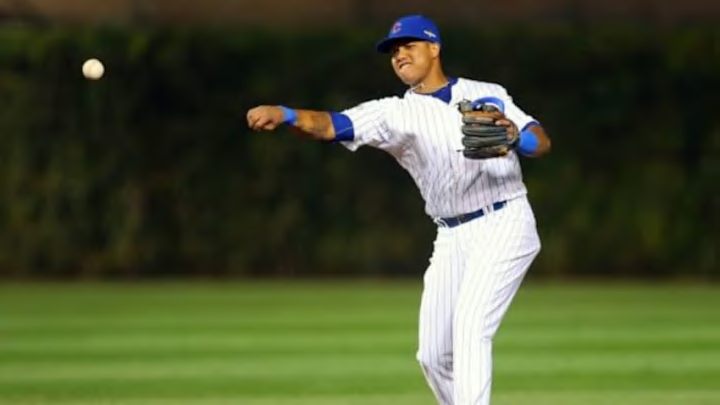The New York Yankees have the look of an unpredictable team heading into Spring Training, with a handful of questionable players whose success or failure will have major impacts on the team’s performance in 2016.
Will veteran lineup stalwarts like Mark Teixeira and Alex Rodriguez replicate last year’s unexpected production? Will intended ace Masahiro Tanaka stay healthy? Will Michael Pineda more consistently live up to his talent level on the mound?
But the player who perhaps fits the title of “X-factor” the most is newcomer Starlin Castro. The Yankees acquired the infielder from the Cubs in December to assume the role of starting second baseman.
More from Call to the Pen
- Philadelphia Phillies, ready for a stretch run, bomb St. Louis Cardinals
- Philadelphia Phillies: The 4 players on the franchise’s Mount Rushmore
- Boston Red Sox fans should be upset over Mookie Betts’ comment
- Analyzing the Boston Red Sox trade for Dave Henderson and Spike Owen
- 2023 MLB postseason likely to have a strange look without Yankees, Red Sox, Cardinals
For the second straight year after the departure of Robinson Cano, second base was a black hole for the Yanks in 2015. Yankees second basemen hit a paltry .223 last season; only the White Sox and Diamondbacks posted worse marks at the position. The .683 OPS manufactured by Yankees second basemen wasn’t much better, placing 22nd out of the 30 big league clubs.
The primary culprit? Stephen Drew, a name Yankees fans bemoaned often throughout the previous campaign. Aside from his 17 home runs, Drew failed to contribute much of anything positive with his regular spot in the lineup, instead spending much of his season attempting to remain above the Mendoza line. He just barely completed that task, finishing the year with a .201 batting average. Overall, he put up a .201/.271/.381 slash line in 131 games on the season.
As the offseason began, the Yanks could have gone in a number of directions at second base. Minor league prospect Rob Refsnyder got his first taste of MLB action last year and had become a popular name among a fanbase starving for young talent. Utility man Dustin Ackley, acquired from the Mariners via trade during the season, was another possibility.
However, GM Brian Cashman decided to roll the dice by swinging a deal with the Cubs for Castro. The young infielder made his debut in 2010 to significant fanfare, as he had been named the top prospect in the Cubs system prior to the season by Baseball America. Despite the expectations and hype, his experience at the major league level has been somewhat of a mixed bag over his six-year career.
Castro led the National League with 207 hits in 2011, slashing .307/.341/.432 with ten homers, 66 RBIs and 22 stolen bases on the year. Not bad for your sophomore season in the big leagues. He managed career highs in home runs (14), RBIs (78) and steals (25) the following year, but his slash line slipped a bit to .283/.323/.430.
He endured his weakest season to date in 2013, posting a .631 OPS, a personal low. The next year brought much improved numbers (.777 OPS) and a return to the All-Star Game, his third. 2015 proved to be another challenge, however, as Castro fell well short of the bar he set the year before. He slashed an unremarkable .265/.296/.375 with 11 homers and 69 RBIs.
Though it would be difficult to call Castro an outright disappoint based on his first six years in the league, he certainly hasn’t always lived up to his early promise. And with the emergence of other young phenoms like Kris Bryant and Addison Russell, Castro was starting to get lost in the shuffle in Chicago. His position on the field was even beginning to fluctuate: after playing his entire major league career at shortstop, Castro made 38 appearances last year at second base.
There are plenty of reasons for the Yankees to hope they’re investing in Castro at the right time, however. Though he’s already spent several years on the MLB stage, he’ll still only be turning 26 years old next month. A change of scenery and a fresh start could be exactly what Castro needs at this point in his career.
His numbers at the plate also perked up dramatically after his late-season shift to second base. In the season’s final two months, he slashed .335/.362/.555 with six homers and 25 RBIs, helping him end a middling campaign on a definite high note. While it’s a relatively small sample size and could simply be coincidental, the Yankees won’t mind if there’s a correlation since he’s poised to become their new starter at second.
Even if Castro repeats his numbers from a year ago, he would still represent an improvement over Stephen Drew and the other spare parts the Yankees were trotting out at second base in 2015. Naturally, Castro and the Yankees are setting their sights higher than that. If he bounces back and manages something in the vein of his 2011 or 2014 seasons, he’ll be a huge boost to the bottom of the Yankees batting order.
For the Yankees offense to be successful in the upcoming campaign, veterans like Teixeira and A-Rod are going to need to stay healthy and perform as well at the plate as they did in 2015. At ages 35 and 40, respectively, that’s not the safest bet. However, solid seasons from players like Castro would help pick up the slack from any decline in the elder statesmen.
Next: Yankees Spring Training Preview
Castro’s performance this season also has important long-term implications for the franchise. He’s currently signed through 2019, so if he succeeds, he could form a nice middle infield partnership with shortstop Didi Gregorius (arbitration eligible through 2019) for several years to come. For a team looking to build a young, athletic foundation for the future, that would be a welcome development.
